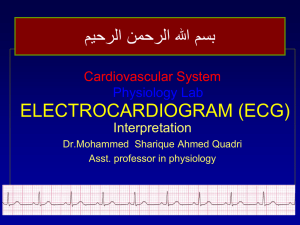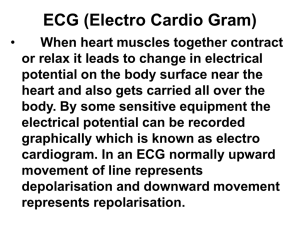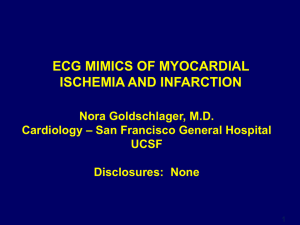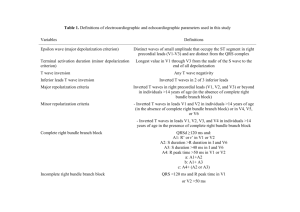12 LEAD EKG BASICS
advertisement
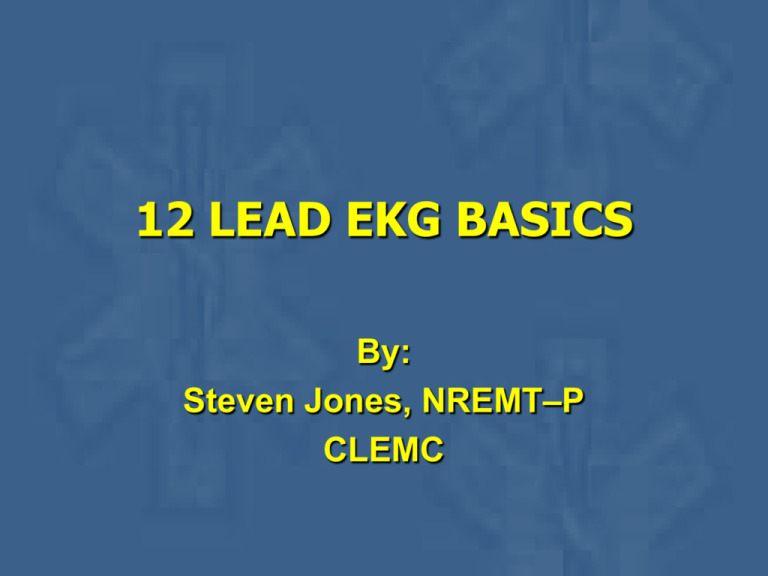
12 LEAD EKG BASICS By: Steven Jones, NREMT–P CLEMC ECG Review Waves and Intervals P wave: the sequential activation (depolarization) of the right and left atria QRS complex: right and left ventricular depolarization (normally the ventricles are activated simultaneously) ST-T wave: ventricular repolarization U wave: origin for this wave is not clear - but probably represents "afterdepolarizations" in the ventricles ECG Review PR interval: time interval from onset of atrial depolarization (P wave) to onset of ventricular depolarization (QRS complex) QRS duration: duration of ventricular muscle depolarization QT interval: duration of ventricular depolarization and repolarization RR interval: duration of ventricular cardiac cycle (an indicator of ventricular rate) PP interval: duration of atrial cycle (an indicator of atrial rate) ECG Review Orientation to 12 Lead Each of the 12 leads represents a particular orientation in space, as indicated below (RA = right arm; LA = left arm, LF = left foot): Bipolar Limb Leads Lead I: RA (-) to LA (+) (Right Left, or lateral) Lead II: RA (-) to LF (+) (Superior Inferior) Lead III: LA (-) to LF (+) (Superior Inferior) Orientation to 12 Lead Augmented unipolar limb leads (frontal plane): Lead aVR: RA (+) to [LA & LF] (-) (Rightward) Lead aVL: LA (+) to [RA & LF] (-) (Leftward) Lead aVF: LF (+) to [RA & LA] (-) (Inferior) Unipolar (+) chest leads (horizontal plane): Leads V1, V2, V3: (Posterior Anterior) Leads V4, V5, V6:(Right Left, or lateral) Limb Lead Placement Limb leads can be placed on the inside of the arms and legs Limb leads can also be place with the arm lead at the mid-clavicular line right below the clavicles and the Leg leads at the border of the lowest ribs. V1 through V6 Placement V1 V2 V3 V4 V5 V6 - fourth intercostal, right sternal border. fourth intercostal, left sternal border. equal distance between V2 and V4. fifth intercostal, left mid clavicular line. anterior axillary line, same level with V4. mid axillary line, same level with V4 and V5. The “Method” of ECG Interpretation This "method" is recommended when reading all 12-lead ECG's. Like the physical examination, it is desirable to follow a standardized sequence of steps in order to avoid missing subtle abnormalities in the ECG tracing, some of which may have clinical importance. The 6 major sections in the "method" should be considered in the following order: Measurements Rhythm Analysis Conduction Analysis Waveform Description ECG Interpretation Comparison of previous ECG (Not used in prehospital care) Measurements Heart Rate PR Interval Normal 0.12 to 0.20s Short <0.12s look for WPW, Junctional Rhythm, or possibly a normal variant Long >0.20s look for a heart block QRS Duration (width of the QRS) 60 to 100 normal Normal 0.06-0.10s Duration of 0.10-0.12s Look for incomplete right or left BBB Duration of >0.12s Look for Complete RBBB, LBBB, or a etopic ventricular rhythm QT Interval (Start of the QRS to end of T wave) >0.46s look for polymorphic V-Tach or Torsades Rhythm Analysis State basic rhythm (e.g., "normal sinus rhythm", "atrial fibrillation", etc.) Identify additional rhythm events if present (e.g., "PVC's", "PAC's", etc) Consider all rhythm events from atria, AV junction, and ventricles Conduction Analysis "Normal" conduction implies normal sino-atrial (SA), atrio-ventricular (AV), and intraventricular (IV) conduction. Conduction Analysis SA Block: 2nd Degree type I or type II AV Block: 1st, 2nd type I and type II and 3rd degree IV Block: BBB Waveform Description Carefully analyze the 12-lead ECG for abnormalities in each of the waveforms in the order in which they appear: P-waves, QRS complexes, ST segments, T waves, and... Don't forget the U waves. P waves: are they too wide, too tall, look funny (i.e., are they ectopic), etc.? QRS complexes: look for pathologic Q waves, abnormal voltage, etc. ST segments: look for abnormal ST elevation and/or depression. T waves: look for abnormally inverted T waves. U waves: look for prominent or inverted U waves. ECG Interpretation This is the conclusion of the above analyses. Interpret the ECG as "Normal", or "Abnormal". Occasionally the term "borderline" is used if unsure about the significance of certain findings. ST Elevation In a sense, the term "ST segment" is a misnomer, because a discrete ST segment distinct from the T wave is usually absent. More often the ST-T wave is a smooth, continuous waveform beginning with the J-point (end of QRS), slowly rising to the peak of the T and followed by a rapid descent to the isoelectric baseline or the onset of the U wave. This gives rise to an asymmetrical T wave. The normal T wave is usually in the same direction as the QRS except in the right precordial leads. In the normal ECG the T wave is always upright in leads I, II, V3-6, and always inverted in lead aVR. Identifying a AMI on an ECG The ECG changes reflecting this sequence usually follow a well-known pattern depending on the location and size of the MI. MI's resulting from total coronary occlusion result in more homogeneous tissue damage and are usually reflected by a Q-wave MI pattern on the ECG. MI's resulting from subtotal occlusion result in more heterogeneous damage, which may be evidenced by a non Q-wave MI pattern on the ECG. Two-thirds of MI's presenting to emergency rooms evolve to non-Q wave MI's, most having ST segment depression or T wave inversion. Cont. In general, the more leads of the 12-lead ECG with MI changes (Q waves and ST elevation), the larger the infarct size and the worse the prognosis. Most common AMI is of the left ventrical. ECG evolution of a Q wave MI Usual ECG evolution of a Q-wave MI; not all of the following patterns may be seen; the time from onset of MI to the final pattern is quite variable and related to the size of MI, the rapidity of reperfusion (if any), and the location of the MI Normal ECG T wave changes with increased amplitude and width may also see ST elevation. Cont. Marked ST elevation with hyperacute T wave hanges (transmural injury) Pathologic Q waves, less ST elevation, terminal T wave inversion (necrosis) (Pathologic Q waves are usually defined as duration >0.04 s or >25% of Rwave amplitude) Pathologic Q waves, T wave inversion (necrosis and fibrosis) Pathologic Q waves, upright T waves (fibrosis) ECG evolution of a Non-Q wave MI Recognized by evolving ST-T changes over time without the formation of pathologic Q waves Although it is tempting to localize the nonQ MI by the particular leads showing ST-T changes, this is probably only valid for the ST segment elevation pattern Evolving ST-T changes may include any of the following patterns: Cont. Convex downward ST segment depression only (common) Convex upwards or straight ST segment elevation only (uncommon) Symmetrical T wave inversion only (common) Combinations of above changes Systematic Infarct Recognition Approach AM I diagnosis criteria: 1mm. or more of ST elevation in 2 or more contiguous leads. Anterior wall requires 2mm. or more of ST elevation (V1-V4) Caution: LBBB Systematic Infarct Recognition Approach Lead Groups INFARCT LOCATION:ST ELEVATION FOUND IN: Anterior – Septal V1, V2, V3, and V4 -- 0.2mV or more in leads Posterior V1, and V2 -- 0.2mV or more in leads Inferior II, III, and aVF -- 0.1mV or more in 2 leads High Lateral I, and aVL -- 0.1mV or more in 2 leads Low Lateral V5, and V6 -- 0.1mV or more in 2 leads "ST Depression indicates Angina" Reciprocal Changes Region of ST Elevation Region ST Depression Anterior (leads V1-V4) Inferior (true posterior) Inferior (leads II, III, aVF) Anterior (leads V1-V3 or lateral lead I aVL) Lateral ( leads I, aVL, V5, V6) Inferior ( leads II, III, aVF) True Posterior V1-V2 Anterior (leads V1-V3)
